 By Mark Gillies
By Mark Gillies
January 27, 2015
BURLINGTON, ON.
Part 1 of a 2 part feature
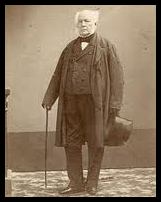
Sir Allan Napier MacNab was a wealthy lawyer, a Prime Minister, a co-founder of The Great Western Railway, including business partner and close friend of Peter Carroll.
Here’s a question for you. When Hamilton’s Sir Allan Napier MacNab the wealthy Prime Minister of Upper Canada, from 1854 to 1856, went dining at a castle in Aldershot, where did he always go?
If you said, Rock Bay, consider yourself a genius. If you have never heard of Rock Bay, don’t feel bad, you are not alone. This is just one more of Burlington’s greatest treasures, regrettably, forgotten over time.
Rock Bay was the first stone castle-like mansion built in the Aldershot area during the early 1850s, by one of Canada’s wealthiest men, Mr. Peter Carroll. Many at the time referred to his residence as Carroll’s Castle, because it did resemble a castle.
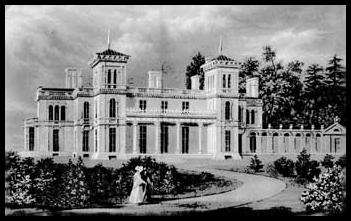
Dundurn Castle was built for Sir Allan MacNab and completed at a cost of $175,000 in 1835. This artist’s impression shows us what Dundurn Castle looked like in this same year.
Dundurn Castle, which we are more aware of, is located at the western end of Burlington Bay on land named Burlington Heights. This beautiful grandiose home built for Sir Allan MacNab, over a 3 year period, was completed in 1835, at a cost of $175,000. We just don’t know about its neighbour, Rock Bay Castle, nor do we know much about Peter Carroll.
What was it that these men had in common? Allan MacNab and Peter Carroll both attained enormous wealth and great power. They were best of friends and business partners. Allan MacNab was a lawyer, but amassed his wealth in land speculation. Peter Carroll was a land surveyor by profession, eventually retiring from this field, in favour of establishing a construction company that built and owned major toll roads across the colonial province. To say the least, this career move was extremely lucrative. Road construction and tolls were the catalysts that launched Peter Carroll into new wealth. Among the many roads in Upper Canada that Peter constructed and owned were these familiar local routes; Waterdown Road, Plains Road (then called the Hamilton and Nelson Gravel Road) and Carlisle Road, plus most roads surrounding Hamilton. Before retiring from land surveying, Peter was responsible for the creation of the grid pattern street layout in Hamilton, a contract offered to him by his good friend, George Hamilton, the founder of Hamilton, Ontario. Peter, under a similar contract, also surveyed the entire Burlington Bay.
Three great minds work together to amass their fortunes
Allan MacNab and George Hamilton were already longtime boyhood friends, both born and raised in Niagara-on-the-Lake. These two men rose to prominence mainly from their efforts in battles during the War of 1812. Helping to defeat the American invasion at Queenston was their crowning achievement in the military. Allan MacNab was knighted by Queen Victoria. Peter Carroll served as a lieutenant-colonel in the militia in these same battles. This is most likely where he first met the other two men, prior to all three setting out seeking fame and fortune after the war ended.
It was basically these three men, after the war, who worked together to shape the future of Hamilton, plus the surrounding areas, including Aldershot. All three men acquired massive tracts of land in this same area, and even abroad. Peter Carroll for one, had extensive land holdings in Iowa and Illinois. All of this land provided the three landowners with unbelievable wealth. These three men influenced the future direction for the Province of Upper Canada, mainly through politics.
Peter Carroll selects a beautiful setting to build his mansion
A spectacular view from Burlington Heights looking east towards Lake Ontario, was the best property for Allan MacNab to build Dundurn Castle. Peter Carroll, not to be outdone, one day, also wanted to have a palatial home with a view overlooking the same Burlington Bay. Unfortunately, the Dundurn Castle site was already taken. As Peter continued to work his way into the power brokers’ circle, with his wealth continuing to dramatically increase, he finally decided it was time to build, and purchased a 40 acre tract of land on the northwest side of Burlington Bay.
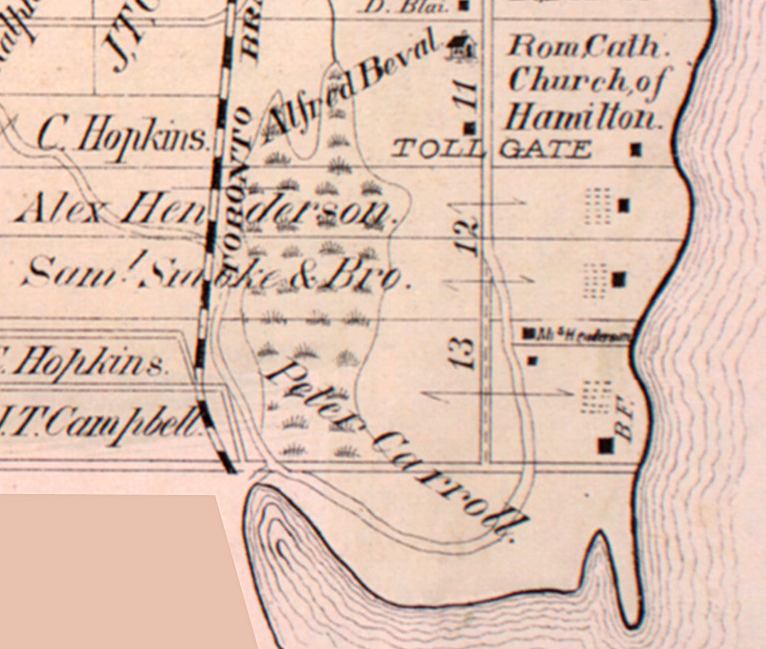
This old land map shows us where Peter Carroll’s property was located in Aldershot. Today, the same property is where Woodland Cemetery, the Royal Botanical Gardens and the Plains Road curve are located.
It was not uncommon for men of great wealth to showcase their success with massive homes. Peter was shrewd enough to not upstage his friend and mentor, Sir Allan MacNab, by building a larger mansion, despite possessing enough wealth. Peter’s home would be on a smaller scale, but would resemble a castle in England. Peter hired an English architect who specialized in manor homes. The architect was brought over to design his new home. The land that Peter Carroll purchased is now occupied by Woodland Cemetery, the Royal Botanical Gardens, and the Plains Road curve in front of the RBG headquarters. The massive stone structure began its construction in the late 1840s. Cut stone was shipped in from a quarry located in Queenston. The mansion was finally ready for occupancy in 1855. The beautiful estate featured a port cochere, stables, outbuildings, a mammoth entrance gate, and small guest lodges located just inside the gates.
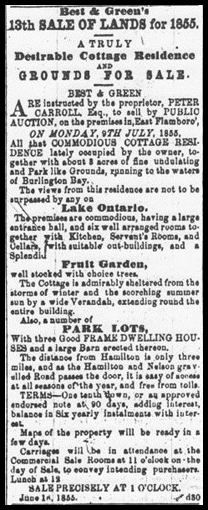
The Bayview cottage was put up for sale by auction in 1855 when Rock Bay was ready for occupancy. The advertisement describes the building, and the grounds available for purchase.
Part of the estate was set aside for farming. Peter Carroll has been identified as one of 2 people to introduce commercial peach farming into Upper Canada. Oak trees were planted on either side of the long winding drive heading towards the mansion, beginning when you turned off from the Hamilton and Nelson Gravel Road. Many of these same oak trees planted on Peter Carroll’s estate are now over 160 years old, and if you position yourself correctly on the grounds of Woodland Cemetery, it is possible to follow the route of the original laneway right to the front entrance of Rock Bay. Peter’s first home in the area, was an oversized board & batten wooden cottage, called Bayview. This building was located on the same property, and was constructed a few years before the mansion was built. When Peter was ready to move in to the larger premises, Bayview was put up for sale by auction.
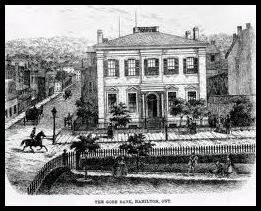
Peter Carroll was on the Board of Directors for several corporations, including the Gore Bank. This drawing is the Gore Bank office in Hamilton.
Peter Carroll sits as a Director on two different banks
As Peter became more influential and powerful, he was invited to be on the Boards of several corporations, including the Bank of Brantford and the Gore Bank. In those days banks issued their own currency in the form of bank notes, but they were actually promissory notes.
A Great Western Railway “Founding Father”
While the mansion was still under construction, and even after Peter Carroll moved in, Sir Allan MacNab and Peter Carroll continued to move along fairly quickly in the business world. They believed a railway was needed to help open up southwestern Upper Canada for more European settlers who were arriving in increasing numbers.
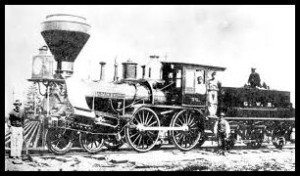
The Great Western Railway built train stations, bridges and track all across southwestern Upper Canada. This is a rare photograph of a very early Great Western Railway locomotive, tender and cars.
One of the greatest achievements for these men, was to finally receive a charter from The Parliament of Upper Canada in 1845, to create the Great Western Railway, 7 years before The Grand Trunk Railway was incorporated in 1852. The new railway company began construction of trains stations, rail lines and bridges, mainly in southwestern Upper Canada. Rail service began in 1853. Sir Allan MacNab became President, and a group of men, mainly prominent lawyers, including Peter Carroll formed the first Board of Directors.
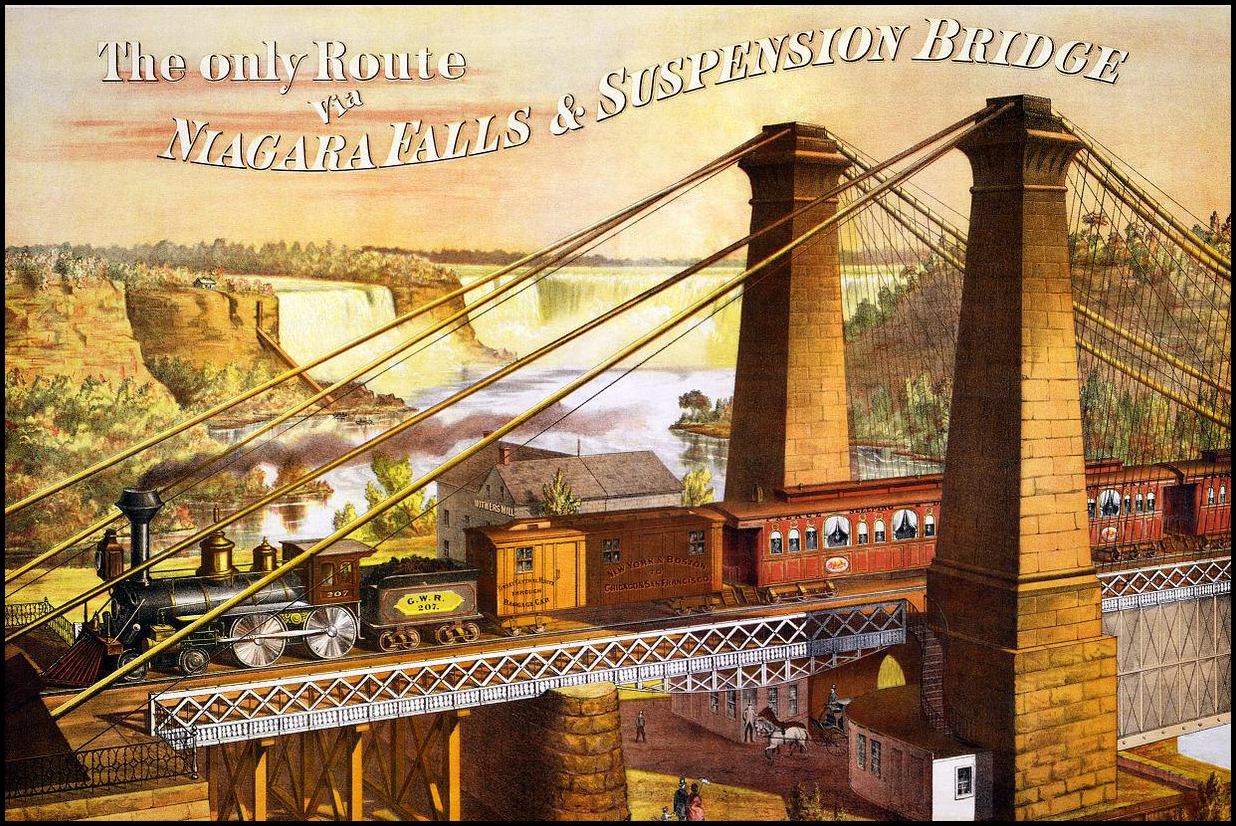
The Great Western Railway was the first in Upper Canada to establish itself as a major player in the market. The drawing of the suspension bridge, a marvel for its time, shows a GTR train crossing. Peter Carroll was on The Board of Directors for the Niagara Suspension Bridge Company and The Great Western Railway Company.
The Niagara Suspension Bridge
Even back in the early 1840s, before their railway charter was awarded, these men realized accessing the bigger American market was going to be key for their financial success. The Great Western Railway Board believed the rail line should one day connect to the United States by a bridge. With that decision made, Peter Carroll became a Director of the Niagara Suspension Bridge Company of Canada. The International Bridge Company of New York was the second company involved with the bridge construction. The two companies would have joint ownership. This first railway suspension bridge in North America was built across the Niagara Gorge, an expanse of 800 feet. The suspension bridge when it opened in 1855 was considered to be an engineering marvel, for its time.
In part 2 of this 2 part feature find out what happened over 100 years ago to this beautiful castle-like mansion. over 100 years ago? See 2 very rare old photographs of what Rock Bay Castle looked like. Whatever happened to Peter Carroll? Why is he not in the history books?



















To my friend Mark Gillies, so very well said.
Heritage is a gift; it is your inheritance from previous generations.
Heritage is all about who they were, and how they lived.
The concept is no different than a monetary inheritance. We have the choice to squander it away, or we can be responsible and do something that will benefit our present and future generations.
Heritage will help us understand who we are.
Heritage is a combination of genes, decisions, and environment, over time.
Heritage cannot be stolen or taken from you, only lost or forgotten through our choices of ignorance, neglect or disuse.
Heritage is your history.
You do not get a second chance at the past.
I cannot thank you enough for these series on Burlington and early founders.
This is so informative. Everyone in Burlington should be reading them.
I know magazines and papers are starting to go on-line as a means of publication but I also know that a lot of people I speak with do not subscribe to the Burlington Gazette (and I tell each one they should). Your series has been so enlightening that in my opinion it should also be in print. Perhaps the City of Burlington itself should have these articles in print and available, in the library or at the tourist office, after all it is our heritage. If people do not know the history how can they know the City.